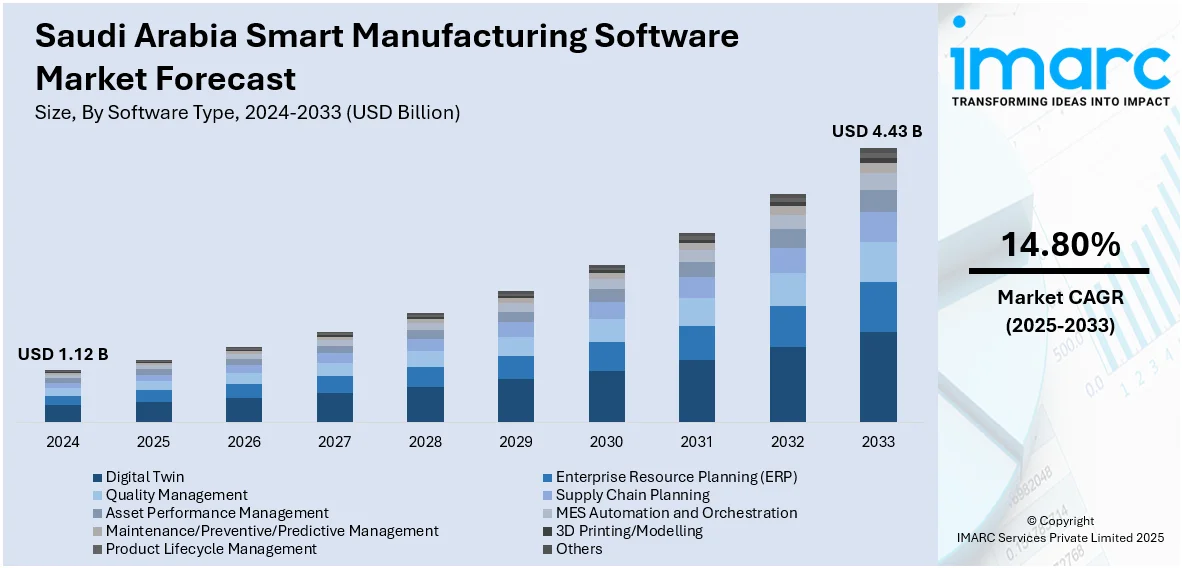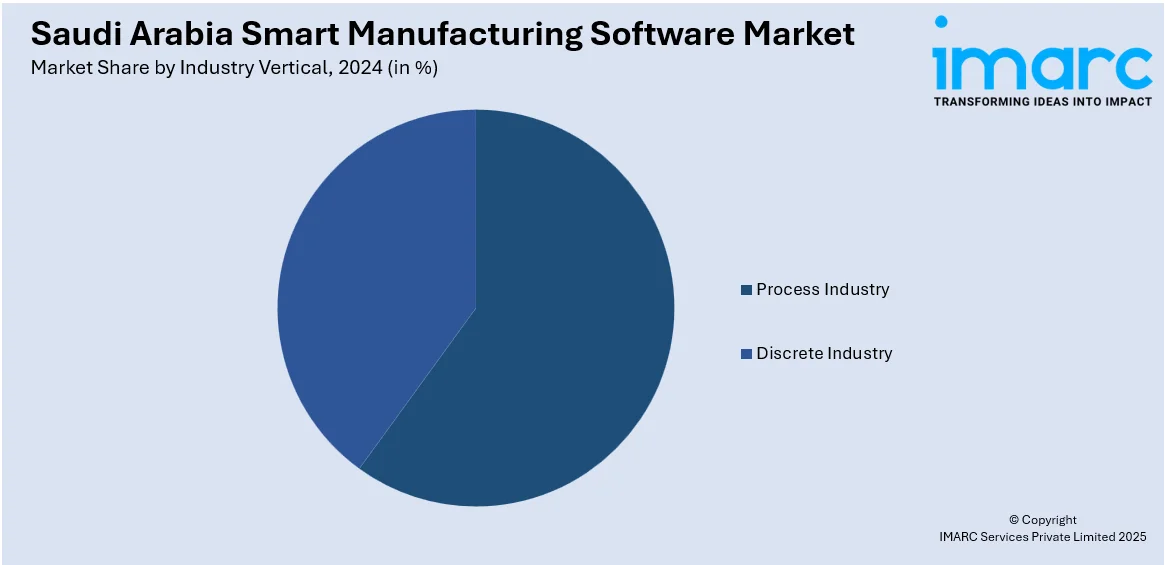
Saudi Arabia Smart Manufacturing Software Market Size, Share, Trends and Forecast by Software Type, Enterprise Size, Deployment Mode, Industry Vertical, and Region, 2025-2033
Saudi Arabia Smart Manufacturing Software Market Overview:
The Saudi Arabia smart manufacturing software market size reached USD 1.12 Billion in 2024. Looking forward, IMARC Group expects the market to reach USD 4.43 Billion by 2033, exhibiting a growth rate (CAGR) of 14.80% during 2025-2033. The main drivers of the market are the government's drive towards digitalization under Vision 2030, increasing adoption of automation across industries, demand for higher operational efficiency, and lowering of the cost of production. Furthermore, widespread use of Industry 4.0 technologies such as IoT, AI, and big data analytics across the industry is contributing to innovation within manufacturing operations, further boosting the Saudi Arabia smart manufacturing software market share.
|
Report Attribute
|
Key Statistics
|
|---|---|
|
Base Year
|
2024
|
|
Forecast Years
|
2025-2033
|
|
Historical Years
|
2019-2024
|
| Market Size in 2024 | USD 1.12 Billion |
| Market Forecast in 2033 | USD 4.43 Billion |
| Market Growth Rate (2025-2033) | 14.80% |
Saudi Arabia Smart Manufacturing Software Market Trends:
Integration of Artificial Intelligence (AI) and Machine Learning (ML)
Saudi Arabia's industrial sector is growing to adopt more AI and machine learning to make production more efficient. For ecample, as per industry report, 87% of regionwide companies have plans for AI/ML investment in 2024, particularly in supply chain and quality control. Energy-intensive sectors and manufacturing of climate change are the drivers that necessitate decarbonization and more intelligent utilization of energy by means of IIoT and analytics. By adopting AI-based solutions, manufacturers are able to forecast maintenance requirements, streamline supply chains, and enhance product quality. Machine learning techniques also allow for real-time data analysis, better decision-making, and automation of processes. The technologies cut downtime, enhance predictive maintenance, and optimize production efficiency to help manufacturers gain cost reductions.

Emphasis on Sustainable Manufacturing Practices
Sustainability is a top concern throughout Saudi Arabia's manufacturing industry, and smart manufacturing software is propelling eco-friendly operations. Manufacturers are finding advantage in software solutions that allow them to monitor energy consumption, reduce waste, and optimize resource usage, which aligns with Saudi Arabia's Vision 2030 vision of environmental sustainability. Industry leaders are increasingly applying technologies such as energy management platforms, smart grids, and waste reduction platforms in order to optimally utilize energy and minimize their environmental footprint. These smart manufacturing solutions not only assist in minimizing carbon emissions but also enhance profitability by lowering operation costs through optimized energy efficiency and waste reduction, thereby driving the Saudi Arabia smart manufacturing software market growth. For instance, in April 2025, Saudi Arabia’s Ministry of Industry and Mineral Resources, in partnership with Deutsche Messe and Riyadh Exhibitions Company, announced the launch of the Industrial Transformation Exhibition, scheduled for December 2025. Part of the Hannover Messe network, this event will showcase advancements in industrial automation, smart manufacturing, and technologies of the Fourth Industrial Revolution. Aiming to boost local production, attract global manufacturers, and foster cross-border collaborations, the exhibition will highlight sectors such as advanced manufacturing, renewable energy, and aerospace, supporting Saudi Arabia’s industrial transformation goals under Vision 2030.
Saudi Arabia Smart Manufacturing Software Market Segmentation:
IMARC Group provides an analysis of the key trends in each segment of the market, along with forecasts at the country and regional levels for 2025-2033. Our report has categorized the market based on software type, enterprise size, deployment mode, and industry vertical.
Software Type Insights:
- Digital Twin
- Enterprise Resource Planning (ERP)
- Quality Management
- Supply Chain Planning
- Asset Performance Management
- MES Automation and Orchestration
- Maintenance/Preventive/Predictive Management
- 3D Printing/Modelling
- Product Lifecycle Management
- Others
The report has provided a detailed breakup and analysis of the market based on the software type. This includes digital twin, enterprise resource planning (ERP), quality management, supply chain planning, asset performance management, MES automation and orchestration, maintenance/preventive/predictive management, 3D printing/modelling, product lifecycle management, and others.
Enterprise Size Insights:
- Large Enterprises
- Small and Mid-sized Enterprises (SMEs)
The report has provided a detailed breakup and analysis of the market based on enterprise size. This includes large enterprises and small and mid-sized enterprises (SMEs).
Deployment Mode Insights:
- Cloud based
- On-premises
The report has provided a detailed breakup and analysis of the market based on deployment mode. This includes cloud-based and on-premises.
Industry Vertical Insights:

- Process Industry
- Oil and Gas
- Power and Energy
- Chemicals
- Pharmaceuticals
- Food and Beverages
- Metal and Mining
- Others
- Discrete Industry
- Automotive
- Electronics and Manufacturing
- Industrial Manufacturing
- Aerospace and Defense
- Others
The report has provided a detailed breakup and analysis of the market based on the industry vertical. This includes process industry (oil and gas, power and energy, chemicals, pharmaceuticals, food and beverages, metal and mining, and others) and discrete industry (automotive, electronics and manufacturing, industrial manufacturing, aerospace and defense, and others).
Regional Insights:
- Northern and Central Region
- Western Region
- Eastern Region
- Southern Region
The report has also provided a comprehensive analysis of all the major regional markets, which include Northern and Central Region, Western Region, Eastern Region, and Southern Region.
Competitive Landscape:
The market research report has also provided a comprehensive analysis of the competitive landscape. Competitive analysis such as market structure, key player positioning, top winning strategies, competitive dashboard, and company evaluation quadrant has been covered in the report. Also, detailed profiles of all major companies have been provided.
Saudi Arabia Smart Manufacturing Software Market News:
- In February 2025, Salesforce announced a $500 million investment in Saudi Arabia's artificial intelligence sector. The investment includes introducing Salesforce's Hyperforce platform, developed in partnership with Amazon Web Services, and expanding the use of Agentforce, a customer service AI tool, through collaborations with Capgemini, Deloitte, Globant, IBM, and PwC. Additionally, Salesforce plans to provide Arabic language support for its AI products, establish a regional headquarters in Riyadh, and upskill 30,000 Saudi citizens by 2030.
- In February 2025, EdgeCortix, a Japan-based AI semiconductor company, was selected by Saudi Arabia’s Ministry of Investment to join the National Semiconductor Hub (NSH) as part of Vision 2030. The company will establish a subsidiary in Riyadh, focusing on edge AI development and engineering. Backed by grants and incentives, EdgeCortix aims to support sectors like smart manufacturing and defense with its energy-efficient AI accelerators. The NSH initiative seeks to attract 50 chip firms, train 5,000 engineers, and drive semiconductor innovation in the Kingdom.
- In February 2024, Rockwell Automation partnered with Saudi Arabia’s SAAK International to digitally transform its production using the Plex MES platform. This move supports Saudi Vision 2030 by improving efficiency, reducing downtime, and increasing productivity. The solution offers real-time production data, customizable dashboards, and operates on Microsoft Azure. It enhances visibility, reduces energy use, and optimizes manufacturing workflows. SAAK aims to scale the system across its facilities, contributing to national goals for economic diversification and technological advancement.
Saudi Arabia Smart Manufacturing Software Market Report Coverage:
| Report Features | Details |
|---|---|
| Base Year of the Analysis | 2024 |
| Historical Period | 2019-2024 |
| Forecast Period | 2025-2033 |
| Units | Billion USD |
| Scope of the Report |
Exploration of Historical Trends and Market Outlook, Industry Catalysts and Challenges, Segment-Wise Historical and Future Market Assessment:
|
| Software Types Covered | Digital Twin, Enterprise Resource Planning (ERP), Quality Management, Supply Chain Planning, Asset Performance Management, MES Automation and Orchestration, Maintenance/Preventive/Predictive Management, 3D Printing/Modelling, Product Lifecycle Management, Others |
| Enterprise Sizes Covered | Large Enterprises, Small and Mid-Sized Enterprises (SMEs) |
| Deployment Modes Covered | Cloud-Based, On-Premises |
| Industry Verticals Covered |
|
| Regions Covered | Northern and Central Region, Western Region, Eastern Region, Southern Region |
| Customization Scope | 10% Free Customization |
| Post-Sale Analyst Support | 10-12 Weeks |
| Delivery Format | PDF and Excel through Email (We can also provide the editable version of the report in PPT/Word format on special request) |
Key Questions Answered in This Report:
- How has the Saudi Arabia smart manufacturing software market performed so far and how will it perform in the coming years?
- What is the breakup of the Saudi Arabia smart manufacturing software market on the basis of software type?
- What is the breakup of the Saudi Arabia smart manufacturing software market on the basis of enterprise size?
- What is the breakup of the Saudi Arabia smart manufacturing software market on the basis of deployment mode?
- What is the breakup of the Saudi Arabia smart manufacturing software market on the basis of industry vertical?
- What is the breakup of the Saudi Arabia smart manufacturing software market on the basis of region?
- What are the various stages in the value chain of the Saudi Arabia smart manufacturing software market?
- What are the key driving factors and challenges in the Saudi Arabia smart manufacturing software market?
- What is the structure of the Saudi Arabia smart manufacturing software market and who are the key players?
- What is the degree of competition in the Saudi Arabia smart manufacturing software market?
Key Benefits for Stakeholders:
- IMARC’s industry report offers a comprehensive quantitative analysis of various market segments, historical and current market trends, market forecasts, and dynamics of the Saudi Arabia smart manufacturing software market from 2019-2033.
- The research report provides the latest information on the market drivers, challenges, and opportunities in the Saudi Arabia smart manufacturing software market.
- Porter's five forces analysis assist stakeholders in assessing the impact of new entrants, competitive rivalry, supplier power, buyer power, and the threat of substitution. It helps stakeholders to analyze the level of competition within the Saudi Arabia smart manufacturing software industry and its attractiveness.
- Competitive landscape allows stakeholders to understand their competitive environment and provides an insight into the current positions of key players in the market.
Need more help?
- Speak to our experienced analysts for insights on the current market scenarios.
- Include additional segments and countries to customize the report as per your requirement.
- Gain an unparalleled competitive advantage in your domain by understanding how to utilize the report and positively impacting your operations and revenue.
- For further assistance, please connect with our analysts.
 Request Customization
Request Customization
 Speak to an Analyst
Speak to an Analyst
 Request Brochure
Request Brochure
 Inquire Before Buying
Inquire Before Buying




.webp)




.webp)












